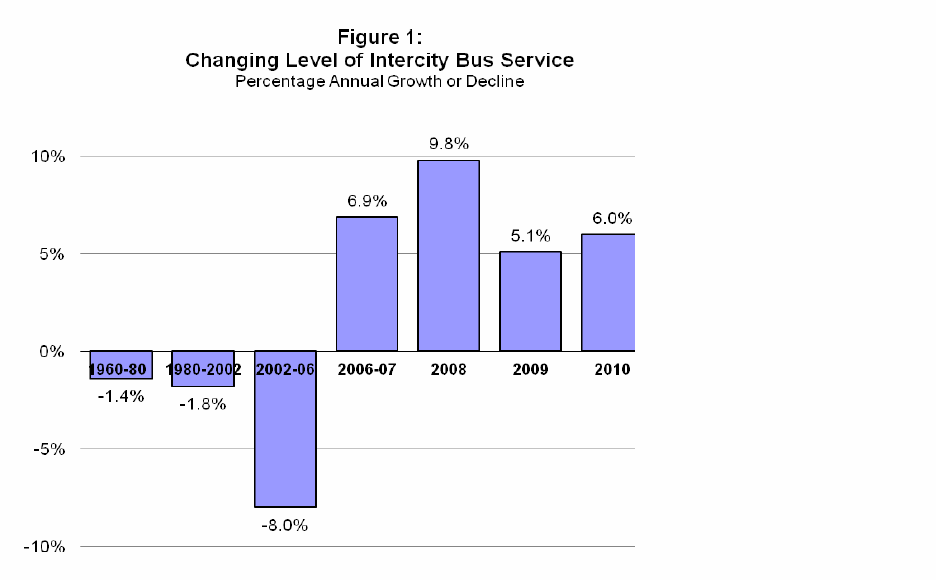CHADDICK INSTITUTE FOR METROPOLITAN DEVELOPMENT, DEPAUL UNIVERSITY
Intercity bus service in the United States remained robust through 2010 as a result of rising travel demand, escalating fuel prices, and investments in new routes. These and other factors propelled motor coach travel to its highest level in years and made the intercity bus the country’s fastest growing mode of transportation for the third year in the row. “Curbside operators,” including BoltBus, DC2NY Bus, and Megabus, which eschew traditional stations in favor of curbside pickup and provide customers access to Wifi and other previously unavailable amenities, enjoyed particular success. Express services linking major cities in the Northeast and Mid-Atlantic states grew at a particularly rapid rate.
This Chaddick Institute briefing provides a status report on the intercity bus sector during the 2010 calendar year. It has two primary objectives: i) to evaluate the extent of the sector’s expansion between 2009 and 2010, and ii) to review the extent to which the recent growth of curbside bus operators is reducing fuel consumption and promoting energy efficiency.
Readers will find a descriptive account of the intercity bus industry’s changing status in The Return of the Intercity Bus: The Decline and Recovery of Scheduled Service, 1960 – 2007, a Chaddick Institute study published in 2008 available at las.depaul.edu/chaddick. This earlier study examines how the opening of interstate highways, increased automobile ownership, and the deterioration of downtown business districts in major cities gradually weakened the demand for intercity bus services. By the mid- 1970s, the intercity bus network was rapidly diminishing. Continued retrenchment took place throughout the 1980s and 1990s—a downturn that continued even after the terrorist acts of September 11, 2001, which dramatically reduced the demand for air travel and led to significant increases in rail traffic.
By 2006, signs of a recovery were readily apparent. “Curbside” bus companies began operating express service on relatively short-distance corridors linking major cities. In some instances, these operators followed the lead of so-called “Chinatown Operators”—bus lines, typically operated by Asian businesses and often in the grey area of the law, offering service between the Chinatown districts of major cities. In other instances, curbside carriers infused new life into markets that hadn’t had seen new service in many years, drawing attention to a mode of transportation mode that had been all but forgotten by many travelers.
The largest and best-known of the curbside operators, Megabus.com (“Megabus”), a subsidiary of Coach USA (owned by Stagecoach, Ltd., a British company) opened its Chicago hub on April 10, 2006. In 2008, DC2NY Bus began service between New York City and Washington, D.C., differentiating its product with wireless internet service and other amenities that could not be found on traditional bus services. Megabus and BoltBus (a joint venture between Greyhound and Peter Pan Lines) soon followed suit and took the model one step further by building full-scale hubs based out of Manhattan. On the West Coast, California Shuttle launched service between the San Francisco Bay Area and Los Angeles, albeit with limited schedule frequency. Megabus also began providing service in California in 2008 but ended operations six months later, selecting to focus their efforts on expanding the Midwest and Northeast markets.
Download full report: The Intercity Bus
About the Chaddick Institute for Metropolitan Development
las.depaul.edu/chaddick
“The Chaddick Institute, located at DePaul University in Chicago, advances the principles of effective land use, transportation and community planning. Founded in 1993, the institute offers planners, attorneys, developers, and entrepreneurs a forum to share expertise on difficult land-use issues through workshops, conferences and policy studies.”
Tags: BoltBus, Chaddick Institute for Metropolitan Development, Chicago, DC2NY Bus, DePaul University, IL, Illinois, Megabus







 RSS Feed
RSS Feed